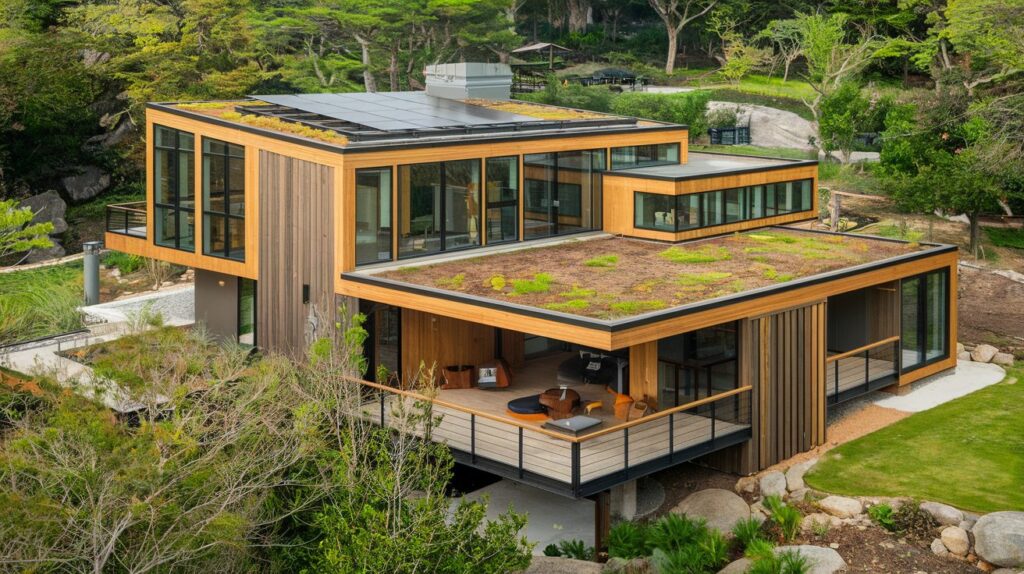Homeowners around the world prefer sustainable, low-maintenance solutions because they help reduce environmental footprints and maintenance expenses. Implementing sustainable building elements during home renovations or new construction projects will help lower maintenance requirements over time. This article provides essential methods for establishing sustainable homes that require minimal upkeep while offering ecological benefits and operational simplicity.
1. Opt for Durable, Sustainable Materials
A sustainable home begins with selecting materials as its foundation. Long-lasting materials that need little maintenance should be your first choice when building a sustainable home. Here are a few examples:
- Recycled Steel: This material is an excellent choice due to its durability, recyclability, weather resistance, and corrosion protection. It’s ideal for building frames, roofing, and structural components.
- Fiber Cement Siding: This exterior wall material provides pest and rot resistance, as well as weatherproof qualities, resulting in reduced maintenance requirements.
- Composite Decking: Combining wood fibers and plastic, composite decking requires less maintenance than traditional wood decks, which need periodic staining and sealing.
These materials maintain their durability over time while minimizing maintenance requirements, allowing you to enjoy your home with minimal upkeep.
2. Stainless Steel Tank Fittings for Efficient Water Systems
When implementing sustainable water systems, such as rainwater harvesting or efficient plumbing, using high-quality fittings is essential for ensuring system longevity and reliability. Stainless steel tank fittings are ideal for these applications because they resist corrosion, are durable, and provide a leak-proof solution. These fittings are crucial in maintaining the functionality and efficiency of your water systems, which is why they are recommended in any eco-friendly, low-maintenance home. By investing in durable components, you can minimize maintenance and avoid costly repairs down the line.
3. Install Energy-Efficient Systems
A home equipped with efficient energy systems will reduce both maintenance requirements and energy expenses. These systems offer better reliability and superior cost efficiency in the long run. Consider these options:
- Modern HVAC Systems: These systems are more efficient than older models, helping both comfort and energy efficiency. Choose a system that suits your climate conditions to reduce energy expenses and maintenance needs.
- LED Lighting: LEDs use less energy and last longer than traditional bulbs, reducing the need for frequent replacements.
- Smart Thermostats: These devices adjust temperature settings according to your schedule, saving energy and extending the lifespan of HVAC systems.
Installing energy-efficient systems will result in a more sustainable home while reducing future maintenance requirements.
4. Water Conservation and Efficient Plumbing
Water conservation plays a significant role in sustainability and low-maintenance living. Implementing water-saving devices and systems lowers water costs and extends the lifespan of plumbing systems. Here are some effective solutions:
- Low-Flow Faucets and Showerheads: These fixtures conserve water without diminishing functionality in bathrooms and kitchens.
- Rainwater Harvesting: This system collects rainwater for irrigation and other purposes, reducing reliance on municipal water supply and preserving natural resources.
- Drip Irrigation: This system delivers water directly to plant roots, reducing waste compared to conventional sprinkler systems, and requires minimal maintenance to keep your garden thriving.
These water-saving systems help preserve resources and reduce maintenance.
5. Low-Maintenance Landscaping
Having a beautiful garden doesn’t necessarily mean it has to be hard to maintain. Your outdoor space can thrive with minimal work by selecting the right choices:
- Native Plants: Native plants thrive in their natural environment, as they are adapted to local climate conditions. They require less water, fertilizer, and pesticides, making them ideal for low-maintenance gardening.
- Mulch: Applying mulch helps retain moisture in the soil, prevents weed growth, and reduces the need for frequent watering. It also improves soil conditions over time.
- Efficient Irrigation Systems: Combining efficient irrigation methods with automated systems ensures that your plants receive optimal care while preventing unnecessary watering.
These landscaping strategies reduce maintenance time, allowing you to enjoy your yard with minimal effort.
6. Smart Home Technology
The integration of smart home technology enables efficient system management, reducing human involvement and saving time. Some smart features to consider include:
- Smart Lighting: Schedule lighting or control it remotely to cut down on energy consumption and avoid unnecessary lighting usage.
- Smart Appliances: These appliances optimize energy consumption, notify users of maintenance requirements, and send alerts about potential costly repairs.
- Advanced Security Systems: These systems offer remote monitoring, providing alerts about security issues and reducing the need for on-site personnel.
Smart home technology enhances daily living while simultaneously promoting sustainable practices and reducing maintenance work.
7. Modular and Prefabricated Homes
Modular and prefabricated homes provide an alternative way to build a low-maintenance, sustainable property. Factory-built homes are assembled on-site, reducing waste and improving construction quality. Modular homes offer customizable features that help achieve your personal style while maintaining energy efficiency. The precise construction of these homes leads to reduced maintenance and fewer repair needs after completion.
Using modular homes or prefabricated components reduces environmental damage during construction, shortens the building process, and lowers maintenance costs in the long run.
Conclusion
By making deliberate choices that support environmental protection and improve your lifestyle, you can create a sustainable home with minimal maintenance needs. Combining durable material selection, energy-efficient system installation, water-saving solutions, and smart technology integration allows homeowners to enjoy a comfortable and efficient home that requires little upkeep. These sustainable practices will transform your property into a model of green living and convenience for many years to come. As your home operates more efficiently, you’ll spend less time and money on maintenance, ultimately benefiting both your family and the planet.

